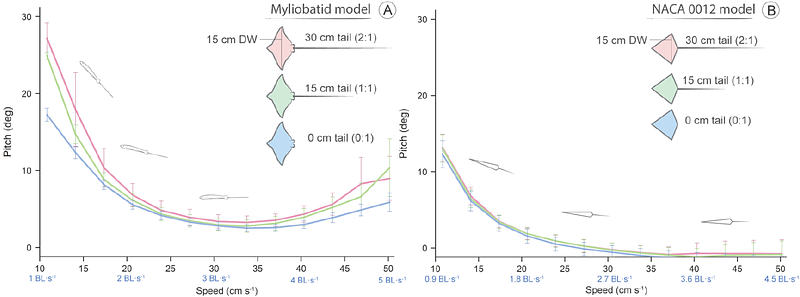The tail of myliobatid rays controls body stability

The tail of myliobatid rays controls body stability
Chaumel, J.; White, C. F.; Lauder, G. V.
AbstractEagle rays, pelagic eagle rays, cownose rays, and manta rays are the only four batoid families exhibiting oscillatory locomotion, and are characterized by expanded pectoral fins and long, slender tails that can exceed body length. This study investigates whether these tails influence body stability during gliding, when the pectoral fins remain extended and held in position. We first measured relative tail lengths across the four families (Rhinopteridae, Myliobatidae, Aetobatidae, and Mobulidae). Using two 3D-printed models based on a myliobatid body and a NACA 0012 shape, we tested the effects of different tail lengths (double, equal to disc width, and no tail) on posture and stability across increasing flow speeds (1 to 4.5 body lengths/second) in a recirculating flow tank. Pitch, roll, and ODBA were recorded via an embedded accelerometer. Our results show that tail length varies among myliobatids, with spotted eagle rays having the longest tails (up to 4 times body length) and giant manta rays the shortest (0.9 times body length). Models without tails exhibited greater instability, particularly increased roll and ODBA. However, tails longer than body length did not provide additional stability or affect pitch. Although tails offered similar results in both models, the tailless NACA model was more unstable at high speeds than the manta body model. We propose that elongate tails of myliobatids enhance stability by generating hydrodynamic drag and exerting a restoring moment around the center of gravity, thereby damping body oscillations. Tails exceeding 0.9 times body length may serve additional functions such as communication, mating, or sensory roles.